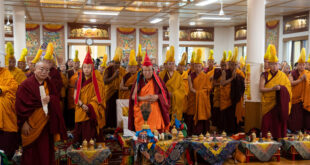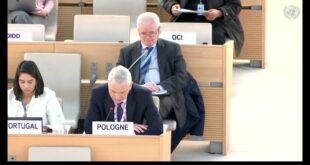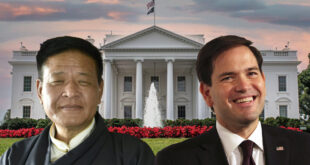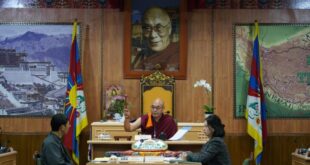Staff Reporter
July 6, 2022
Subscribe
Sikyong Penpa Tsering reading the Kashag’s statement. Photo / Tenzin Phende / CTA
On this auspicious occasion of the eighty-seventh birthday celebration of His Holiness the Dalai Lama, the Kashag – on behalf of the Tibetan people inside and outside Tibet – would like to pay our deep respect by offering warm greetings to His Holiness, and pray that His Holiness remain as the epitome of the well-being of all sentient beings for aeons to come.
For the Tibetans and the people of the world, today is a very special day. Because on this very day, His Holiness the Dalai Lama, a great Bodhisattva and magnanimous giver of love and compassion, was born in this world beset by greed and struggle. Therefore, we would like to extend our warmest greetings to all humanity, including the Tibetans living inside and outside Tibet.
As we celebrate His Holiness the Dalai Lama’s birthday, it is important for us Tibetans to deeply reflect on and understand the enormous services that His Holiness the Dalai Lama has rendered for the cause of Tibet. The best way to repay the gratitude is to maintain good moral conduct and lead a meaningful life by following the counsel of His Holiness the Dalai Lama.
When His Holiness the Dalai Lama assumed Tibet’s spiritual and political leadership, the occupying Chinese communist forces had already defeated the Tibetan army at Chamdo. Despite the tender age of 16, His Holiness tried all possible means to peacefully co-exist with the Chinese forces for eight long years and carried out timely religious and political reforms in Tibet.
Around the same time, His Holiness received monastic education from his tutors and was awarded the Geshe Lharampa degree, equivalent to the highest doctorate in Buddhist philosophy, during the Great Annual Prayer Festival (Monlam Chenmo) in 1959. During the festival, the Chinese government offered an unusual invitation to His Holiness the Dalai Lama to attend a theatrical show at the Chinese military headquarters. The root cause of Tibetans preventing His Holiness from attending the theatrical show lies in the words of Mao Zedong when he, on 24 June 1958, said, “We must make all-round preparation to counter the rebellions in the Tibetan areas. It is extremely good that the counter-revolutionaries of Tibet are rebelling. This will create an opportunity for the labouring masses to be liberated.” The Tibetan’s distrust of the Chinese government’s true intention behind the invite was also fanned by the events already taking place in Kham and Amdo regions, where most of the monasteries were destroyed before 1959. Several Tibetan lamas and leaders were forcibly arrested and killed after being called on the pretext of meetings. As thousands of Tibetans gathered at the Norbulingka Palace to protect His Holiness, the Chinese forces attacked the palace with mortars. Two days later, on 17 March 1959, His Holiness was forced to escape into exile.
His Holiness the Dalai Lama and his entourage arrived at Chudangmo at 2 p.m. on 31 March 1959 and later moved to Mussoorie on 20 April as arranged by the Indian government. On the arrival of His Holiness the Dalai Lama in Chudangmo, India’s Prime Minister Jawaharlal Nehru expressed respect for His Holiness in the Indian parliament. Even though Prime Minister Nehru, during his meeting with His Holiness at Mussoorie on 24th April, expressed his disinclination for the establishment of the Tibetan government in exile, His Holiness on 24th April advised a gathering of Tibetan government officials who came to Mussoorie from Kalimpong to “discuss assignment of works related with the re-establishment of the Tibetan government in accordance with the modern times.” Accordingly, four major departments namely Religion, International Affairs, Home and Finance, and Office of Tibet in Delhi were established. Thus, an administrative foundation was built to carry on the Tibetan struggle and look after the welfare of the Tibetans in exile.
In the initial years, His Holiness the Dalai Lama directed his efforts in compiling documents to let the world know the truth about the destruction of Tibet’s culture, religion and national identity by the Chinese government. Consistent efforts were made to answer questions from the International Commission of Jurists and journalists taking an interest in the Sino-Tibet conflict. Similarly, arrangements were made to rehabilitate the never ending flow of Tibetan refugees into exile in India, Nepal and Bhutan, employing them in road construction to earn a livelihood.
In his address to the first batch of 50 students at the inaugural function of the first Tibetan school in Mussoorie on 3rd March 1960, His Holiness said: “From now on, we can never remain isolated from the world. We must learn the language of India and English, which is the most widely-used world language and study all the modern subjects like world politics, economics and science. At the same time, we should also study our Tibetan language and Buddhism and diverse aspects of our culture. In essence, we should endeavour to make the new younger generation of Tibetans educated in both the spiritual and political fields.” In this way, His Holiness laid out a policy with a blend of traditional and modern education. Moreover, separate schools for Tibetan children under the Central Tibetan Schools Administration were established upon His Holiness’ request to the Indian government so they would not dissipate into the larger Indian fabric. Likewise, Tibetan Children’s Village, Tibetan Homes Foundation, Snow Lion Foundation Schools in Nepal and Sambhota Tibetan Schools Society were established and developed. As a result, a large number of educated Tibetans, who could shoulder the prime responsibilities of looking after the affairs of administration, education and society, were raised.
After moving the Tibetan administration to Dharamshala on 1 May 1960, the plans to educate Tibetan children, preserve and promote Tibetan Buddhism, and rehabilitate old and infirm people came to fruition. Of the new arrivals from Tibet, monks were able to preserve and promote the Tibetan Buddhist tradition. Similarly, Children below the age of 16 were sent to schools, adults were given vocational training and employed in diverse fields like handicrafts, and those of the working age group were facilitated to work in production enterprises, mainly agriculture in the settlements. Moreover, the old and infirm were provided care in old age homes.
On 16 December 1960, the first batch of 666 Tibetan settlers from Chamba, Dalhousie and Kullu Manali were moved to Lugsung Samdupling Settlement in Bylakuppe, the first Tibetan settlement. By 1967, the land was made habitable for 3,000 settlers. By the 1970s, the work related to establishing around 54 Tibetan settlements was complete. With this, His Holiness’ vision of a separate Tibetan settlement, to not only provide a stable living environment for the Tibetans but also to serve as the most important foundation to preserve the Tibetan identity and struggle, materialised.
Meanwhile, efforts were made for the preservation and continuation of the Tibetan religion. The government of India initially agreed to provide for a scholastic community of 300 to be established at Buxa Duar. After a repeated appeal from His Holiness the Dalai Lama, the Indian government consented to provide funding for 1,500 monks of all traditions. Likewise, monastic institutions like Gyuto and Gyumed monasteries were newly established at Dalhousie. Unfortunately, monks at Buxa Duar endured harsh conditions with hot and humid climate and rampant diseases. After a series of discussions about the problem with the Indian government and concerned people, the monks at Buxa were moved to various settlements. These monks would become seeds of monastic institutions representing all the Tibetan religious traditions. These monastic institutions not only preserved and promoted Tibetan Buddhism and linguistic traditions of Tibet and Himalayan regions but also made remarkable contributions by sharing the invaluable Tibetan cultural heritage with the world.
In 2011, His Holiness approved the amendments to the Charter of Tibetans in exile to devolve his political and administrative responsibilities to the democratically-elected Tibetan leadership. It is the culmination of the gradual process of long cherished aspiration to democratise the Tibetan polity carried for the past 50 years. Since the direct election of Kalon Tripa in 2001, His Holiness the Dalai Lama has held a semi-retired position. The setting up of the complete administration comprising of the three pillars of democracy, including the Supreme Justice Commission and three autonomous bodies of Election Commission, Public Service Commission and Audit Commission, with the promulgation of the Charter of the Tibetans in Exile in 1991, is also a decision based upon the 30 years of experience gained since the founding of the Tibetan Parliament in Exile in 1960. In essence, His Holiness the Dalai Lama has led the entire process of the evolution of the Tibetan democratic process through top-down persuasion and leadership.
With the adoption of the Middle-Way Policy to resolve the Sino-Tibet conflict in 1973, the Sino-Tibetan contact began in 1979. Subsequently, Tibetans living in and outside Tibet were allowed to visit their parents and relatives. From 1980 to 2011, 86,225 Tibetans visited India from Tibet to meet their relatives or for pilgrimage. Out of these, 20,668 went to schools, 17,489 joined monasteries and 1,435 settled in India, Nepal and Bhutan. Today, many of them and their children are serving in various sections of the Central Tibetan Administration and other educational, monastic and social institutions.
His Holiness the Dalai Lama made consistent appeals to the United Nations on Sino-Tibet conflict, and as a result, three resolutions on Tibet were passed from 1959 to 1965. In spite of living as refugees amidst the conflicting environment of the cold war era, His Holiness maintained friendly relations with countries in both the east and the west. The widespread solidarity for the Tibetan cause in every nook and corner across the world bears testimony to it.
Taking into consideration the long-term interest of Tibet, His Holiness initiated programmes to educate and resettle Tibetan refugees in western countries. In 1960 hundreds of Tibetan children were sent to Switzerland, followed by the gradual resettlement of about 1,000 Tibetans until 1981. In Canada, 228 Tibetans were resettled as part of the first official resettlement project since 1971. In 1992, the United States government accepted 1,000 Tibetans for resettlement in the country. Similarly, 1,000 Tibetans were sent to Canada for resettlement in 2013. The Australian government began accepting former Tibetan political prisoners and their relatives for resettlement in the country in 1996. Today, the Tibetan Diaspora communities are based in about 30 countries, contributing greatly to Tibet’s political and social cause.
In retrospect, we can say that during the entire course of building the foundation, construction and development of the Tibetan settlements, educational and monastic institutions in exile, there is not a single point where His Holiness the Dalai Lama has not offered his service and personally made his presence. We Tibetans clearly know in our hearts how His Holiness guided and equipped us with education to survive in the new challenging environment and contribute to our cause by leading a meaningful life.
Looking back at the past sixty-three years of exile, His Holiness has established the Tibetan government in exile to sustain the sovereignty of Tibet from the first Tibetan King, Nyatri Tsenpo, to the Gaden Phodrang government and to strengthen and develop in line with changing times and aspirations of the Tibetan people. In order to build a strong sense of a single unified identity among Tibetans of all the three provinces of Tibet and to enable the Tibetans to live together and not dissipate in the host country, Tibet settlements with sustainable means of livelihood like agriculture, handicraft and business, were established. Similarly, Tibetan-administered schools, colleges, monastic institutions, and traditional Tibetan and Allopathic medical institutions facilitating the Tibetan community is unseen in any other refugee community. All this has materialised due to the singular effort of His Holiness the Dalai Lama. On this occasion, the Kashag would also like to extend its deep appreciation to the older generation of Tibetan civil servants who worked under His Holiness’s leadership.
According to mysterious predictions and as per his own wishes, His Holiness the Dalai Lama has repeatedly assured us that he could live to the age of 113. To realise this, we appeal to all the Tibetans to follow the wise counsel of His Holiness, especially the four principal commitments and accumulate our collective merit through engaging in virtuous activities. Furthermore, we must pool our united effort towards our common cause and shun deeds that would cause concern and nuisance to His Holiness. On our part, the Kashag is carrying out its responsibilities in accordance with the guidance of His Holiness the Dalai Lama and remains committed to fulfilling his aspirations.
The 16th Kashag, since its beginning, has been making efforts to bring necessary changes to the administrative structure alongside ensuring a sound system of governance, executing well-thought projects and adopting means to achieve ends as per the changing times. Similarly, visits to assess the situation in the Tibetan settlements and to reach out to and build awareness on the Sino-Tibet conflict in the international community are very much underway. Last month the administration extended all cooperation and support to the World Parliamentarians’ Convention on Tibet organised by the Tibetan Parliament-in-Exile in Washington DC. At that time, the U.S. Congressional-Executive Committee on China conducted a meaningful hearing on the historical status of Tibet.
The Central Tibetan Administration will soon conduct a demographic survey of Tibetans in exile. Accurate data on the Tibetan population in the diaspora is crucial for the effective implementation of programmes, e-governance, distribution of schemes and the electoral process. Therefore, the Kashag appeals to all the Tibetans in exile to participate and extend their cooperation in this important exercise.
Finally, I pray for the long life of His Holiness the Dalai Lama, the protector of the sentient beings in general and the Tibetans in particular, and for the spontaneous fulfilment of all his wishes. May the truth of the cause of Tibet prevail soon!
The Kashag
6 July 2022
*Note: This is a translation of the Tibetan statement. Should any discrepancies arise, please treat the Tibetan version as final and authoritative.




